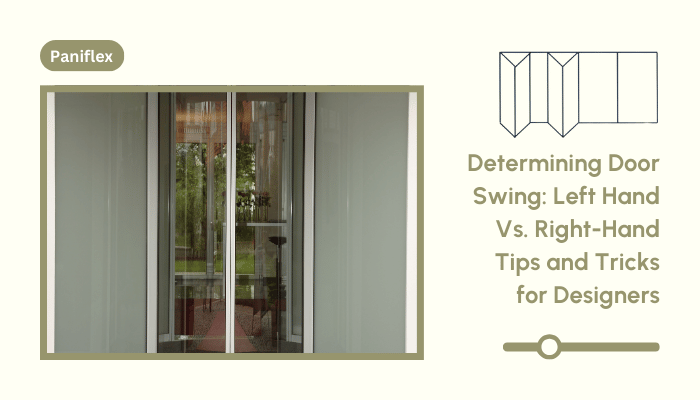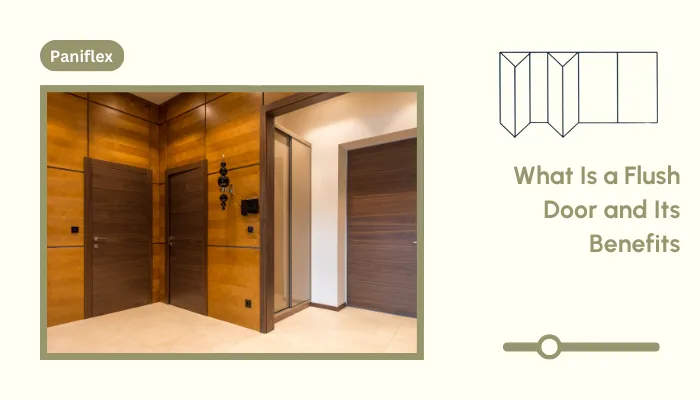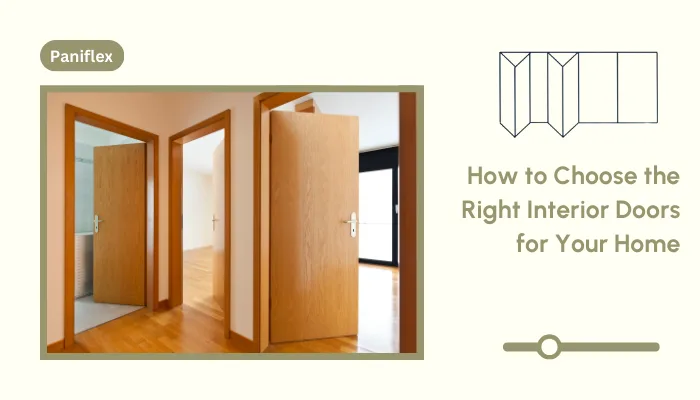Introduction
As an interior designer or architect, you know that the devil is in the details. Door swing can significantly impact both functionality and aesthetics. Whether designing a custom closet, planning a home renovation, or working on a commercial project, understanding how to determine a door swing is crucial for creating seamless, user-friendly spaces.
In this comprehensive guide, we’ll explore the intricacies of left-hand and right-hand door configurations, providing you with the knowledge and tools to make informed decisions for your clients. Let’s unlock the secrets of door swing determination and elevate your design expertise.
Ensuring Correct Door Handing
When replacing an existing door or installing a new one, getting the swing direction right is paramount. Here’s a foolproof method to determine door swing:
- Stand in the doorway: Position yourself with your back to the hinges. This is your starting point for accurate assessment.
- Observe the doorknob location: Take note of which side the doorknob is on – right or left. Determining handedness requires this observation.
- Interpret the position: You will determine if it’s a right-hand or left-hand door based on the side where you locate the doorknob. If it’s on your right, it’s a right-hand door; if on your left, it’s a left-hand door.
- Alternative method: If you prefer, face the closed door from the side it opens towards. The side where the handle is located determines the handling. This method can be beneficial when you can’t stand in the doorway.
By mastering these techniques, you’ll ensure that every door specification in your projects is accurate, leading to smoother installations and satisfied clients.
Ready to experience the benefits of custom closet doors? Explore our range of Paniflex products now.
How to Determine the Handing of a Door
Let’s break down the process step-by-step for a more precise understanding:
- Position yourself correctly: Stand with your back against the hinge side of the door frame. Accurate determination requires this positioning.
- Extend your arms: Imagine you’re about to open the door. Extend your arms as if reaching for the handle, mimicking the action of opening the door.
- Observing door latch side: Once positioned with your back against the hinge side and your arms extended, note which hand is closer to the door latch or doorknob. You can determine the handedness of the door from this. If your right hand is closer, it’s a right-handed door. If your left hand is closer, you’ve got a left-handed door.
- Right-Handed vs. Left-Handed Doors: Understanding the difference is key. A right-handed door will swing towards your right when you pull it open from the latch side, while a left-handed door will swing towards your left.
Also Read: Guide to Standard Residential Interior Door Sizes
Remember, this method works for inswing and outswing doors, making it a versatile technique for all door types you might encounter in your design projects.
Essential Considerations for Door Swing Direction
When designing spaces, you’ll encounter four main types of door swings, each with its applications and considerations:
- Left Inswing: When facing the door from outside, it opens inward with the handle on the left side.
- Right Inswing: When facing the door from the outside, the handle on the right side opens inward.
- Left Outswing: When facing the door from the inside, it opens outward with the handle on the left side.
- Right Outswing: The door opens outward with the handle on the right side when facing the door from inside.
Depending on the room’s layout, function, and spatial constraints, you will determine the place of each type in the design. For instance:
- Bathroom doors typically open inward for privacy and to prevent blocking hallways.
- Closet doors might be better suited as an outswing to maximize interior space and provide full access to the contents.
- In commercial settings, emergency exit doors are often outswing for quick evacuation.
Always double-check your measurements and swing direction before ordering custom doors to avoid common installation errors. This is especially crucial when working with specialized doors, like those offered by Paniflex for custom closet solutions. Their bifold and sliding doors can be customized to fit your design needs, ensuring functionality and style.
Determining Door Swing during Installation
For new door and jamb installations, follow these detailed steps:
- Identify the hinge side: Look at the rough opening and determine which side will house the hinges. The room’s layout and intended door function typically determine this.
- Position yourself correctly: Stand with your back against the hinge side of the rough opening, mimicking the door’s closed position.
- Extend your arms: Reach out as if you’re opening the door. Visualize the door’s movement with this action.
- Determine handedness: The hand closest to where the handle would be determines the swing. If it’s your right hand, you need a right-handed door; if it’s your left, you need a left-handed door.
- Consider the rough opening: You must prepare the rough opening correctly for the door swing you’ve determined. This includes proper framing and clearance for the door’s movement.
This method ensures you order the correct configuration for a perfect fit when working with Paniflex’s custom closet doors. You can tailor their precision-crafted doors to your specific measurements and swing requirements, enhancing your closet designs’ functionality and aesthetics.
Regarding specialized requirements, let’s dig deeper into determining door handing for exit devices.
Determining Door Handling for Exit Devices
Exit devices, often used in commercial and public buildings, require special attention:
- Understand the “outside” or secure side: People typically enter the building or space from this side.
- Determine the direction of ingress: Identify which way people will enter through the door.
- Specify the correct device: Use this information to specify LHR (Left Hand Reverse) or RHR (Right Hand Reverse) devices. LHR is used when the device is mounted on the left side of the door when viewed from the secure side, while RHR is used when it’s mounted on the right.
- Consider building codes: Ensure your specification meets local building codes and safety standards for emergency exits.
With this knowledge, you must maintain building safety standards while achieving your design vision, especially in commercial or public spaces where proper egress is critical.
Now that we’ve covered exit devices, let’s wrap things up with some general rules and final tips for door handings.
General Rules and Final Tips
Familiarize yourself with universal door designations to communicate effectively with suppliers and installers:
- RH (Right Hand): Hinges on the right, when viewed from outside, swing inward.
- LH (Left Hand): Hinges on the left, when viewed from outside, swing inward.
- LHR (Left Hand Reverse): Hinges on the left swing outward when viewed from outside.
- RHR (Right Hand Reverse): Hinges on the right swing outward when viewed from outside.
For exterior doors, consider these factors when choosing between inswing and outswing configurations:
- Security: You might find outswing doors more secure as the hinges are not exposed.
- Weather protection: Inswing doors generally offer better protection against the elements.
- Space constraints: You must consider the door swing’s impact on interior and exterior spaces.
Practical Quick Tips and Simplified Methods
Here’s a visual guide to quickly determine door handedness in any situation:
- Back to hinges: Always start by standing with your back to the hinges or hinge side of the opening.
- Imagine opening: Visualize yourself opening the door from this position.
- Natural hand position: The hand reaching for the handle indicates the door’s handling. If it’s your right hand, it’s a right-handed door; if it’s your left, it’s left-handed.
- Quick check: Remember, the hinge side determines everything. If you can see the hinges, you’re on the wrong side!
By mastering these techniques, you’ll ensure that every door in your design projects functions flawlessly. Whether you’re working on a sleek modern office, a cozy residential space, or a complex commercial project, proper door swing determination is key to a polished final product.
Ready to elevate your door design game?
Also Read: Step by Step Guide To Prehung Exterior Door Installation
Ready to experience the benefits of custom closet doors? Explore our range of Paniflex products now.
Conclusion
Remember, when dealing with custom closet solutions, Paniflex offers a range of door styles tailored to your specific project needs. Their expert team can assist you in selecting the perfect door configuration to complement your design vision, ensuring that every detail, from swing direction to finish, aligns perfectly with your overall concept.
Explore Paniflex’s custom closet door options and bring a new level of sophistication to your interior design projects. Visit their website to discover how their precision-crafted doors can enhance your next design venture, offering the perfect blend of functionality and style that your discerning clients demand.






